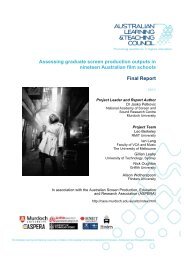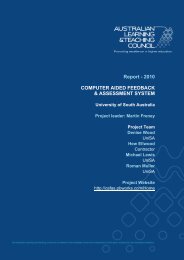Download Document - Office for Learning and Teaching
Download Document - Office for Learning and Teaching
Download Document - Office for Learning and Teaching
Create successful ePaper yourself
Turn your PDF publications into a flip-book with our unique Google optimized e-Paper software.
Avoid cheating <strong>and</strong> plagiarismAustralian universities treat plagiarism seriously. Be clear about the university rulesgoverning cheating <strong>and</strong> referencing. In general, cheating is the inclusion of theunacknowledged work of another person. Plagiarism (presenting other people'swork <strong>and</strong> ideas as your own) always risks a heavy penalty. If you are caughtplagiarising, it generally results in a zero mark <strong>for</strong> part or all of the assignment, <strong>and</strong>a serious offender may face failing the unit or subject.Make ef<strong>for</strong>t in your assignment tasksPay attention to not only those parts that apply key theory/skills covered by the unit/subject, but also those minor requirements, such as structural/<strong>for</strong>mattingrequirements, submission requirements, etc. Never be careless about yourassignment – if you don’t care about your assignment, no one else will. Theconsequence of this will be losing marks unnecessarily, which may contribute to apoor final result <strong>for</strong> the unit or subject.(3) Use Available ResourcesUse wisely the available resources/materials providedIt is important to be clear about the purpose of different materials provided to you.They all serve different (but complementary) purposes. Generally, the study guideprovides the key in<strong>for</strong>mation <strong>and</strong> the flow of the subject. PowerPoint slidessummarise the key concepts of topics (including the key points of readings) <strong>and</strong>include any updated in<strong>for</strong>mation that is too recent to have been included in the studyguide, as well as questions <strong>and</strong> cases <strong>for</strong> in-class discussions <strong>and</strong> activities. Thetextbook is the place where you can find more thorough explanations of terminology<strong>and</strong> more detailed in<strong>for</strong>mation on concepts <strong>and</strong> applications discussed in the studyguide <strong>and</strong>/or mentioned in the PowerPoint slides. In addition, almost all the casestudies <strong>and</strong> activities prescribed in the study guide are included in the textbook.Finally, the readings present you with extra in<strong>for</strong>mation which is not covered or onlytouched on in the textbook <strong>and</strong> the study guide146
















